The Orcas conclude today with the award for Best Crossword. Before we get to the last award, let’s recap the winners thus far:
- Best Easy Crossword, Lynn Lempel
- Merl Reagle Award for Best Sunday-Sized Crossword, Jeremy Newton
- Best Freestyle Crossword, Natan Last
- Best Tournament Crossword, Joon Pahk
- Best Meta/Contest Crossword, Matt Gaffney
- Best Gimmick Crossword, Jeff Chen and David Steinberg (tie)
- Bob Klahn Award for Best Clue, Peter Gordon
- Margaret Farrar Constructor of the Year Award, Patrick Berry
Will one of these puzzles win Best Crossword? Click “Continue reading” to find out!
2015 was a memorable year in crosswords, for reasons good and bad. On the happy side, we saw two daily puzzles launch, one at the Wall Street Journal and another on BuzzFeed (though sadly, the latter no longer runs five days a week). The Indie 500 Tournament was a smashing success in its inaugural year. And our fearless leader got a new kidney!
But 2015 was also a year of incredible loss, with the deaths of constructors Merl Reagle and Henry Hook, editor Leslie Billig, top solver Doug Hoylman, and fellow puzzle-head Tom Gazzola. I’m not sure any of us can recall a single year in which so many from our happy tribe left us.
Through happy and sad, however, there continued to be one constant: the crossword puzzle. As we observed yesterday, more than 1,800 puzzles were reviewed on this site, and there are hundreds more quality puzzles that don’t get regular love here (see the Fireball Newsflash crossword and the various indie crossword offerings of Andy Kravis, Erik Agard, Chris King, Kameron Austin Collins, Tim Croce, Todd McClary, and Sam Ezersky, to name a few). From this deep pool come eight fantastic, beloved puzzles–this year’s Best Crossword nominees.
Today’s winner joins an illustrious group of puzzles that have earned Best Crossword honors:
- 2011: “Moving Day,” by Matt Gaffney (MGWCC #169)
- 2012: Untitled, by Ben Tausig (Onion AV Club) (the “up-down” puzzle)
- 2013: Untitled, by Patrick Blindauer (New York Times) (the “double feature” puzzle)
- 2014: “Repeat Offenders,” by Francis Heaney (MGWCC #330)
So let’s get to this year’s nominees, listed (as always) in order of publication date:
-

- “Flip-Flops,” by Patrick Berry
“Flip-Flops” by Patrick Berry (New York Times, February 22). One of the nominees for the Merl Reagle Award for Best Sunday-sized Crossword, this Patrick Berry offering was the one where hidden words in the theme entries shifted up or down a row, as appropriate to the clue. So, as you can see in the screen shot to the right, the END in TENDERHEARTED shifted up (“end up”) while the LIE in SALIERI shifted down (“lie down”). So all Patrick had to do was find hidden words in interesting words and phrases that would be appropriate starts to “up” and “down” that could stack upon each other in symmetrical locations throughout the grid. Yep, that’s all. The GOES UP AND DOWN revealer almost looks like an afterthought, yet it makes sure every section of the grid is occupied with thematic material. This puzzle gets more marvelous every time you look at it and think about the serious chops required in the construction. And yet it didn’t even win the Reagle Award! That honor went to…
-

- “Upsides,” by Jeremy Newton
“Upsides” by Jeremy Newton (New York Times, March 22). If 2014 was the year of the Schrodinger puzzle, 2015 might have been the year of the turning puzzle. An unusually high number of puzzles had theme answer taking turns in the grid (recall the origami puzzle discussed yesterday). But this took the turning cake, so to speak, as 24(!) entries along the left and right edges took a 90-degree turn, making it so all of them at some point went “up the sides” of the puzzle (hence the title). One wonders if this started as a Thursday puzzle with UPSIDES as a revealer in the middle but turned into a Sunday puzzle when the 15×15 grid proved too restrictive. Regardless, this puzzle just brings it when it comes to theme execution. And what I love most is that the six Downs that really crawl up also work as legitimate Downs by themselves. Oh, and the neighboring Downs would be forgiven if they were lackluster since they too consist of stacked theme material–and yet there’s stuff like THE LEFT, DRESS UP, SEXTS, A AND E, BIOLABS, and DIE DOWN. To have all that turning stacked like it is in every case with fresh, playful crossings is just amazing. What will he do for an encore?
-

- “Ode to Crosswords” by Matt Gaffney
“Ode to Crosswords” by Matt Gaffney (MGWCC #356, March 27). The screen shot doesn’t really do the Orca winner for Best Meta/Contest crossword justice, for the beauty of this puzzle is in the 72 clues that form 24 haikus (haikues? haikueues?). The 11th syllable in each haiku phonetically tells solvers to write their own haikus as part of the entry submission process. Toss in the fact that the theme entries in the grid form a haiku and that the puzzle instructions were in haiku and you have a theme executed deftly at every turn. I solved this puzzle with a group of friends at the American Crossword Puzzle Tournament, and there was unbridled joy in finding the secret message in the 11th syllables of each haiku. Between solving the puzzle and the meta, we probably spent 45 minutes on the puzzle. I have this feeling that was a very small fraction of the time Matt spent in building the puzzle and writing all the clues. The gimmick may have been apparent from the length of the clues, but the construction was simply masterful.
-
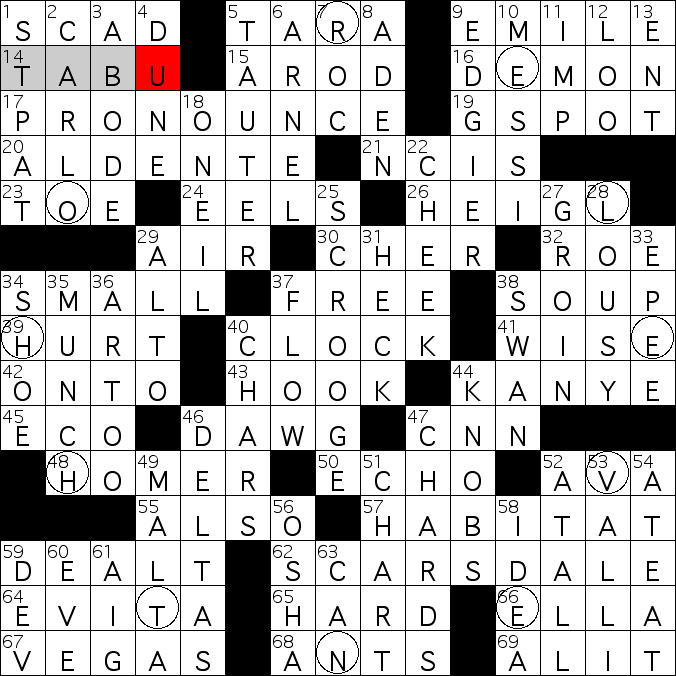
- “Time and Time Again,” by Evan Birnholz
“Time and Time Again” by Evan Birnholz (MGWCC #372, July 17). Twenty-two clues in this meta puzzle contain numbers. Two of them contain “one,” two of them contain “two,” and so on. If you note where the answers cross, they form a CLOCK, the central entry in the grid. For example, TARA is clued as [Fictional neighbor of Twelve Oaks] and ROC is clued as [Beast with quills “twelve paces long,” according to Marco Polo]. Those answers cross at the R, and in this grid, that would be the 12 o’clock position. You’ll see similar results for everything except the 11 o’clock spot–no “eleven” clues anywhere, much less at the red square in the screen shot where they should be. That’s because the meta answer was ELEVENTH HOUR, the “two-word description of something missing” from the puzzle. Great concept! But what really elevates this puzzle is the unforced incorporation of the numbers in the clues. To keep the fill smooth, the grid has 82 answers, four more than the usual 78-word cap applicable to themed puzzles. But that was the right choice–just one of many made throughout the execution of this concept. Readers dug it, too–a 4.73 average star rating with 28 of 40 voters awarding it the full five stars.
-
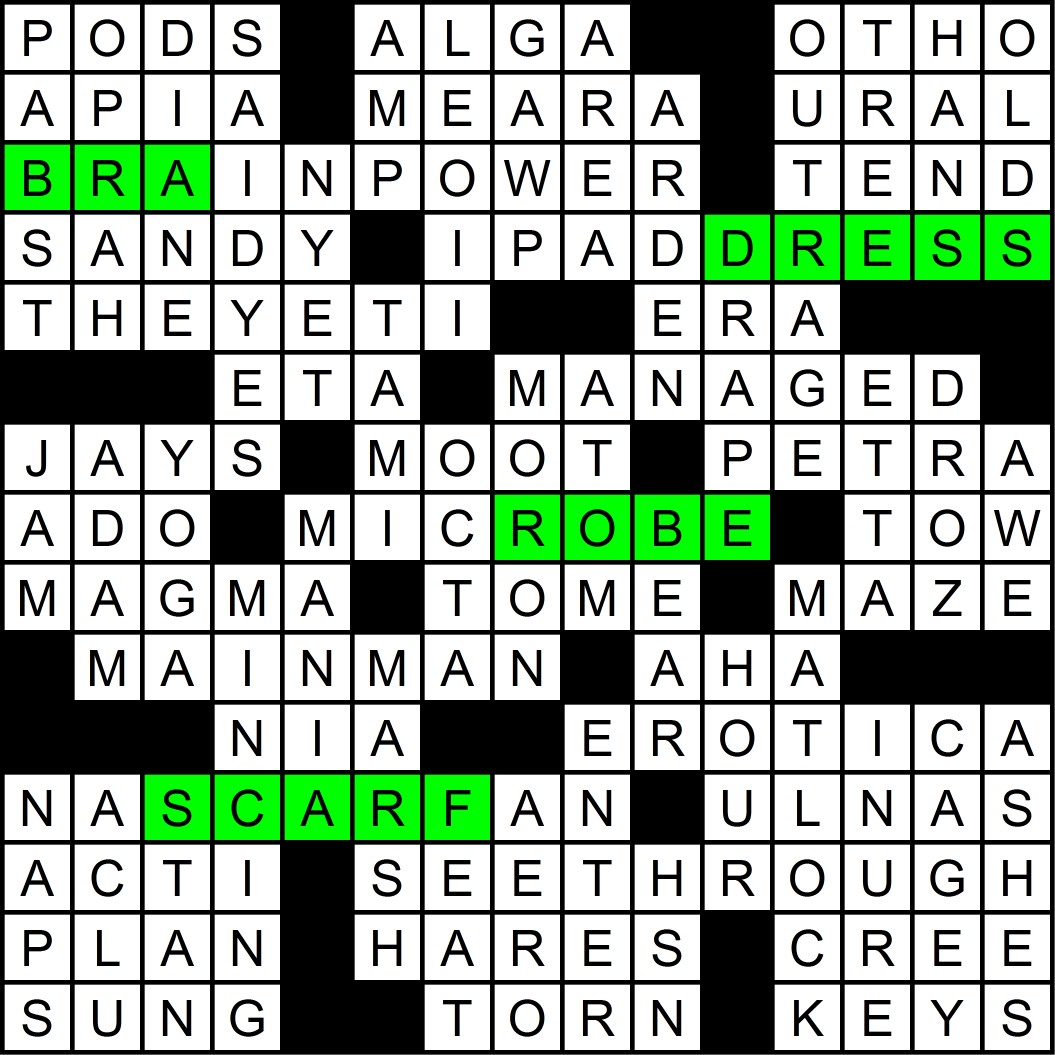
- “Wearing Thin,” by Jeff Chen
“Wearing Thin” by Jeff Chen (AV Club Crosswords, July 22). This is one of the co-winners of the Best Gimmick Crossword Orca. (The other one just missed the cut for a nomination–we always follow the tradition of matching the number of Best Crossword nominees with the number of Best Picture Oscar nominees.) It was the SEE-THROUGH puzzle, in which solvers could peek through the sheer garments hidden inside the four theme answers because the crossing Downs contained two clues, one for the word that includes the “sheer” letter and one that ignores it. So in the Down that crosses IP ADDRESS and MICROBE there is a clue for both DRAPE and RAP. Get ready to see more “ignore a letter” gimmicks in the coming years that build off this fun (but challenging to construct) concept.
-
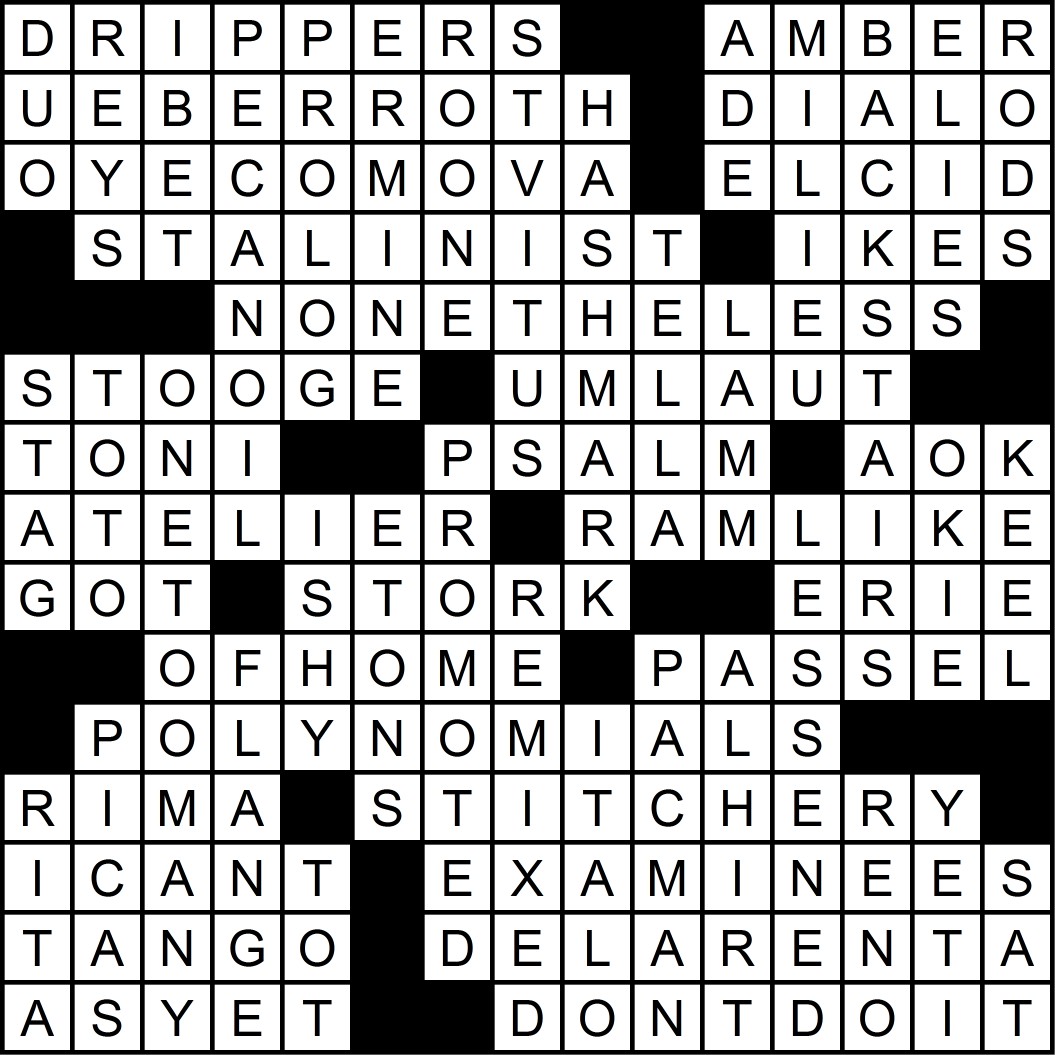
- Merl’s original grid
“M is for Merl” by Matt Gaffney (MGWCC #378, August 28). In introducing the puzzle, Matt posted Merl’s grid from the 1985 U.S. Open crossword tournament, calling it the best freestyle puzzle ever created in the pre-database era. Indeed, that grid’s amazing. You can see right away how Matt paid tribute: he created his own not-quite-freestyle grid using the very same design. Matt later disclosed that he turned to an anonymous friend with a large database to help fill this grid, because, you see, it wasn’t entirely a freestyle puzzle. There’s a meta answer buried in there. Note the puzzle’s title–it suggests looking for the nine Ms in Merl’s grid, then seeing what letters appear in those same positions in Matt’s grid.

Matt’s version
The new letters, when read from top to bottom, spell MASTERFUL (see Matt’s version to the right, with the appropriate letters circled). Such an apt meta answer for such a beautifully touching tribute puzzle. Our readers were certainly touched–the puzzle nabbed 19 five-star ratings and a 4.81 average from 24 total ratings. With fresh fill that pops like, well, POPPIN’ FRESH (along with HAVE A HEART, HAIRNETS, SET ABOUT, and MEAT-EATER), one hardly notices the constraints involved in making this puzzle work. This is truly elegant work, and yet another fitting tribute puzzle to Merl (recall Trip Payne’s tournament puzzle from Crosswords LA, an Orca nominee for Best Tournament Crossword).
-
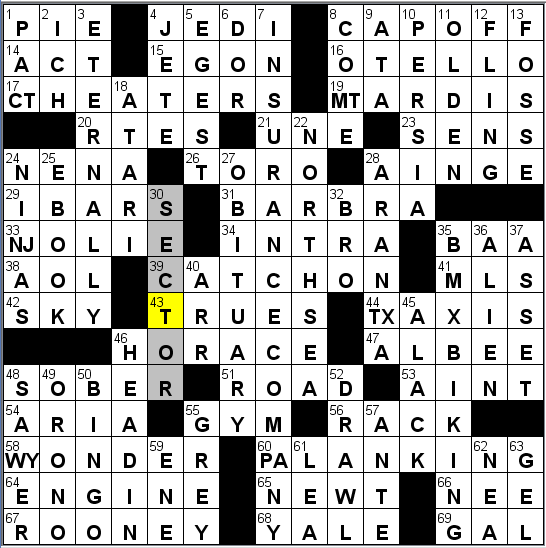
- “Heads of State,” by Brendan Emmett Quigley
“Heads of State” by Brendan Emmett Quigley (American Values Club Crossword, November 18). This was a nominee for Best Gimmick Crossword, and it’s easy to see why so many solvers loved it (4.86 average from 25 readers, with 21 five-star ratings). Each of the letters in six postal abbreviations is used to turn one word into two (CHEATER’S THEATERS, TAXI’S X-AXIS, etc.), and both letters are required for the crossing Downs (as in PACT and ARANTXA Sanchez-Vicario). I continue to be most impressed by the fact BEQ chose abbreviations with rare letters, which really upped the difficulty level. Mortal constructors would have steered toward the abbreviations with easier, common letters. But Brendan pulls it off as only he and maybe a handful of others could. This puzzle’s proof that he continues to be at the top of his game.
-
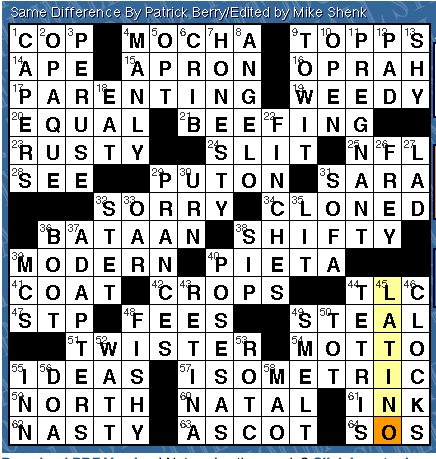
“Same Difference,” by Patrick Berry
“Same Difference” by Patrick Berry (Wall Street Journal, December 18). This was the Best Meta/Contest puzzle nominee where five pairs of answers shared the same clue. Solvers had to figure out that one answer was an anagram of the other with one additional letter. Thus, FISHY and SHIFTY, both clued as [Suspicious], are nearly anagrams except that SHIFTY contains an additional letter, I. The other four pairs share the same quality, and the five added letters work to spell TWINS, the meta answer. Elegantly simple, and deftly executed. Yep, that’s a Patrick Berry puzzle. Our readers had comments like “wow,” “brilliant,” and “Loveditloveditlovedit!” (The last one should have left off the final “loved it” to be more thematically appropriate.)
Congratulations to all the nominees! Time to announce the winner. The Best Crossword is…
“Upsides,” by Jeremy Newton! A 4.76 average star rating feels right for this masterpiece, despite the suspicion we have about the integrity of the votes. (Recall, this puzzle got 91 ratings, a full 33% more than any other puzzle from 2015.) There’s a case to be made, actually, that the average rating should be higher. This puzzle has everything you want in a crossword: an innovative theme, a satisfying “aha moment” when the solver catches on to the concept, thematic density, no compromises in the non-thematic crossings, and zippiness in the fill. As Amy observed in a comment earlier this week, this puzzle, the first 21×21 to nab Best Crossword honors, could be one Patrick Berry wishes he made. Mic drop.
That’s a wrap! Thanks as always to Amy for giving The Orcas a home, to Dave Sullivan for technical support, and to the readers of this blog for taking the time to assign ratings and leave comments. Most importantly, thanks to crossword constructors and editors for another fun year of solving. The Golden Age of Crosswords continues!
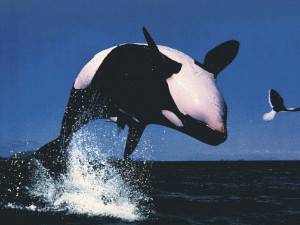
> despite the suspicion we have about the integrity of the votes.
Welp… thanks, everyone? While sincerely honored, I’m also thoroughly confused by the “suspicion we have about the integrity of the votes.” Is that accusation meant for me? Or is the idea that someone who reeeeeally wanted me to win an Orca Award rallied really hard? In any case, makes a boy feel like an interrupted Taylor Swift on the Orca stage. I suppose I have to say in my defense, wasn’t me!
At the end of the day, this is a fun look back and a celebration of the creativity from the past year. And it’s humbling and amazing to be mentioned in the same breath as Evan, Matt, Brendan, Jeff, and Patrick. You’re all puzzle gods – I’m a big fan of you all.
Bye,
Jeremy
It will be in USA Today next week…
Zing